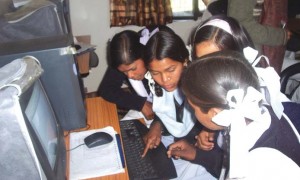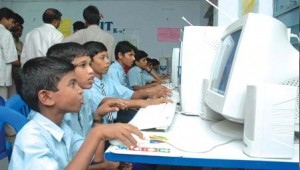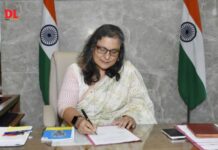 If we start counting theilliterates, the number is more in India than any country in the world, but at the same time India has highly competent human resources as well as a strong base in information and communication technologies (ICT). India has one of the largest ICT workforces in the world. The country has made major strides over recent decades, increasing by six-fold the number of children enrolled in primary schooling. Still recent government analyses show that more than 25% (59 million school-aged children) are not now in school, and probably a larger number of older youth received little or no schooling at all. Another dimension of the concern for increased quality of education in India is the relative lack of ICT resources and access in the schools. In light of these growing concerns for universal basic education, the Government of India is moving forward with a variety of plans to increase access to education for all sectors of Indian society and now with a design to take advantage of ICTs to assist in all dimensions of school education, it has drafted the ICT in schools scheme that can influence the country’s overall growth other than opening up the window of ICT readiness in education sector only
If we start counting theilliterates, the number is more in India than any country in the world, but at the same time India has highly competent human resources as well as a strong base in information and communication technologies (ICT). India has one of the largest ICT workforces in the world. The country has made major strides over recent decades, increasing by six-fold the number of children enrolled in primary schooling. Still recent government analyses show that more than 25% (59 million school-aged children) are not now in school, and probably a larger number of older youth received little or no schooling at all. Another dimension of the concern for increased quality of education in India is the relative lack of ICT resources and access in the schools. In light of these growing concerns for universal basic education, the Government of India is moving forward with a variety of plans to increase access to education for all sectors of Indian society and now with a design to take advantage of ICTs to assist in all dimensions of school education, it has drafted the ICT in schools scheme that can influence the country’s overall growth other than opening up the window of ICT readiness in education sector only
India recognised the importance of ICT in education as early as 1984- 85 with the Computer Literacy And Studies in Schools (CLASS) Project introduced as a pilot. A total of 12,000 computers were distributed to secondary and senior secondary schools through the State Governments. 2598 schools including 325 Kendriya Vidyalayas were covered under the CLASS scheme during the 8th Plan for providing instructors, maintenance of hardware, consumables and textbooks for students and training of teachers in schools. During the 9th Plan period, CLASS scheme was discontinued and a revised scheme was launched during 2001-02. The review of the scheme has shown that in spite of challenges in implementing the CLASS scheme, the overall response that it has generated
in the various states has been extremely encouraging. Some states like West Bengal, Andhra Pradesh, Tamil Nadu, Chattisgarh and Manipur have achieved remarkable success. National Task Force on Information Technology and Software Development constituted by the Prime Minister in July 1998 then made specific recommendations on introduction of IT in the education sector including schools. The Report recommended provision of computer systems to all educational Institutions up to Higher Secondary/ Secondary Schools by suitable investments (about 1-3%) of the total budget during the next five years. The centrally sponsored scheme of ‘Educational Technology’ and ‘CLASS’ have been suitably modified eeping in view the past experience, the feedback which has been received and changing needs to form the new scheme of ‘ICT in Schools’. The ‘ICT in Schools’ scheme is a window of opportunity to the learners in the schools of India to bridge the digital divide. The scheme is not a simple merger of the earlier CLASS and ET Schemes but is a comprehensive and well thought-out initiative to open new vistas of learning and to provide a level playing field to school students, whether in rural areas or in the metropolitan cities. The ‘ICT in Schools’ Scheme is not a stand-alone scheme while actively soliciting the partnership of States, Union Territories & other organisations in a mutual endeavour.
Financial parameters
The States would have the option to incur expenditure to an overall maximum limit of INR6.70 lakhs per school. The Central Government’s share would be restricted to INR5.00 lakhs per school.
Managing further
At least two schools in each of the identified educationally backward blocks would be taken up for assistance under the ICT in Schools scheme. The provision for software shall include Learning Management Systems & curriculum based courseware apart from operating systems & other application software. Kendriya Vidyalayas and Navodaya Vidyalaya Samitis would convert one school per State/Union Territory into a SMART school subject to availability of funds. At least one section (of 40 students) in each of the class IX – XII is hoped to be fully computerised. Thus a school having 160 computers @ 40 computer for each IX to XII classes may be called a SMART school under the scheme. Both KVS and NVS have identified the schools, which will be converted into a SMART School.
 Proposed activities
Proposed activities
The project will illustrate the following activities. • Production of Audio, Video and Multi Media programmes in the project mode by the State Institutes of Educational Technology established at Pune, Bhubaneswar, Patna, Lucknow, Hyderabad, Ahmedabad and Thiruvananthapuram • Training to teachers and teacher trainers in the production of lowcost audio-visual aids, help in script development, media production, editing, communication research, setting up and operation of audio and video studios and computerisation of its various processes by Central Institute of Education Technology/State Institutes of Education Technology (SIET) • Financial support to States/UTson the basis of their Computer Education Plans • Support to KVS/NVS for opening of SMART schools and for imparting computer literacy to students in neighbourhood schools Development of multimedia content for use in schools • Development of teaching tools, designing training modules for teachers • Financial support for conversion of content into regional languages • Projects for introduction of use of technology for the education of children with special needs • Training of teachers and master trainers/resource persons in the use of ICT tools for nrichment of curriculum and pedagogy Apart from being evaluated by the Project Monitoring and Evaluation Group that would function as the Monitoring Committee, there is possibility of getting the ‘ICT in Schools’ scheme evaluated through an independent agency. Detailed guidelines to facilitate implementation of the scheme shall be issued by the Ministry of Human Resource Development, Government of India.

























